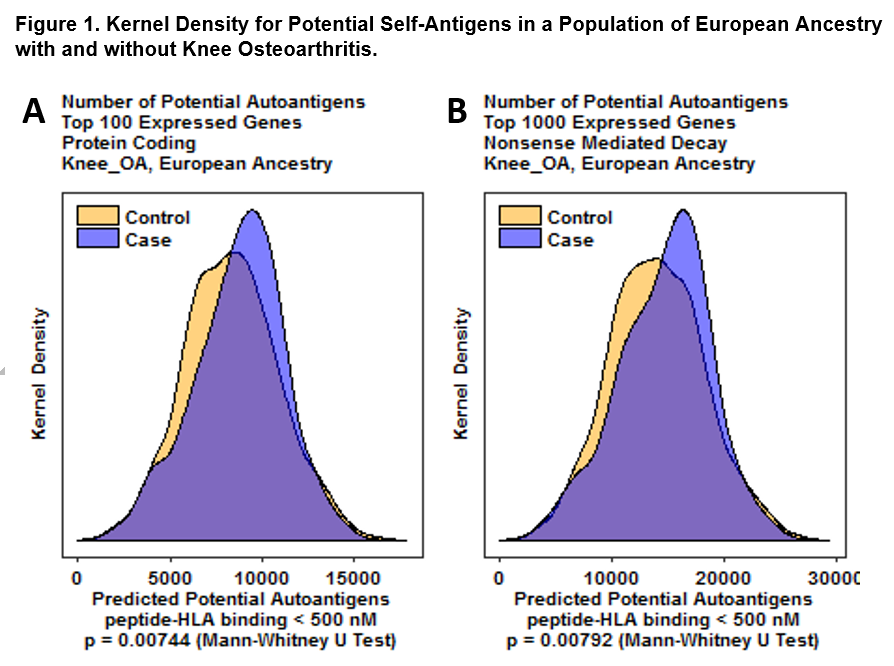Session Information
Session Type: ACR Poster Session B
Session Time: 9:00AM-11:00AM
Background/Purpose: Recent work in a subpopulation of individuals with osteoarthritis (OA) suggests that T cells are (1) responding to auto-antigenic stimuli (e.g. peptidoglycan epitopes), (2) not being effectively quieted by peripheral tolerance mechanisms, and (3) driving local inflammation. In this study, we assessed the possibility that in OA, T cells are responding to self-antigen peptides (SAP) bound more tightly to HLA by measuring OA-HLA associations and SAP-HLA binding distributions in a large community-based cohort, the Johnston County (JoCo) OA Project.
Methods: We included 1477 JoCo OA participants of European Ancestry (EA) and defined hip or knee OA as having both symptoms and a Kellgren-Lawrence grade of 2 or more in a given joint. We imputed HLA from SNP data using SNP2HLA and verified imputation accuracy using 1000 Genomes Project data. To evaluate the effect of cumulative potential SAP-HLA binding, we used NetMHCpan to predict binding of the reference peptidome to each sample HLA for coding transcripts from the top 100 genes and nonsense mediated decay (NMD) transcripts from the top 1000 genes expressed in synovium. Chi-square tests for HLA with allele frequency >2% were used to discover individual HLA association with knee and hip OA, accounting for multiple comparisons with Bonferroni and Benjamini-Hochberg FDR adjustment. Mann-Whitney U tests were used to compare cumulative potential SAP-HLA binding distributions for participants with and without OA.
Results: HLA imputation identified 94% of 2-digit HLA types and 87% of 4-digit subtypes in the European 1000 Genomes Super-Population. HLA-B*35:01 associated with knee OA from within the group of B alleles after adjustment (Table 1). Cumulative potential SAP-HLA binding for both protein coding transcripts and NMD transcripts also associated with knee OA (Figure 1).
Conclusion: An individual’s HLA type affects the potential space of SAP which can bind tightly and be presented to T cells. HLA-B*35:01 was weakly associated with knee OA in the EA JoCo subset. We hypothesize that it is the cumulative propensity for highly expressed synovial peptides to bind to an individual’s HLA that determines a baseline level of knee OA risk, which is then augmented by joint injury, obesity, aging, or other factors that increase local inflammation and/or expose a higher burden of synovial SAP to T cells.
To cite this abstract in AMA style:
Lansford J, Arbeeva L, Vincent B, Jordan JM, Loeser R, Nelson A. Computational Analysis of Potential Self-Antigens in Osteoarthritis [abstract]. Arthritis Rheumatol. 2018; 70 (suppl 9). https://acrabstracts.org/abstract/computational-analysis-of-potential-self-antigens-in-osteoarthritis/. Accessed .« Back to 2018 ACR/ARHP Annual Meeting
ACR Meeting Abstracts - https://acrabstracts.org/abstract/computational-analysis-of-potential-self-antigens-in-osteoarthritis/


